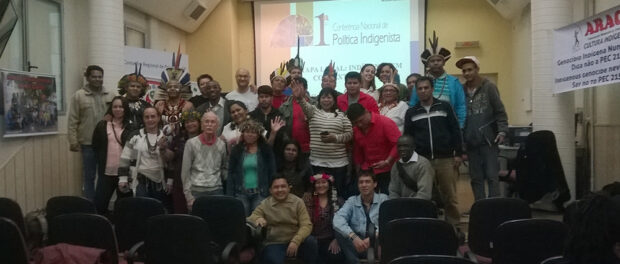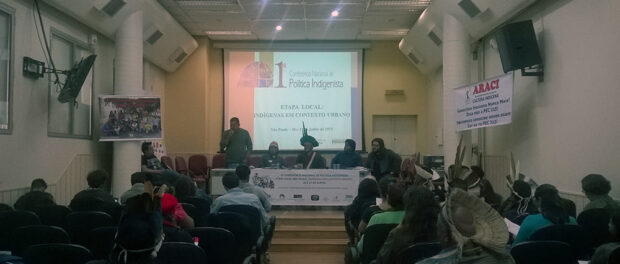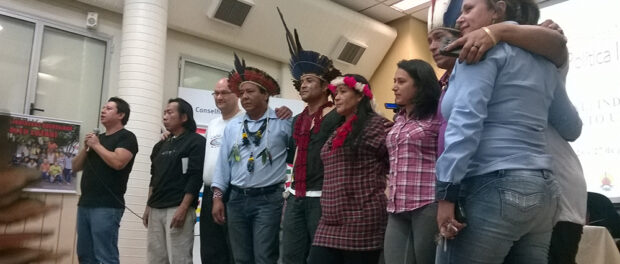
Indigenous peoples from the cities of Rio de Janeiro and São Paulo gathered on the weekend of June 26 for the first national conference on indigenous policies in São Paulo. The national conference aimed to evaluate the state’s indigenous policies, reaffirm indigenous rights and propose guidelines and frameworks for state actions. It emerged out of a demand by indigenous peoples, and its seats were occupied by indigenous representatives. Out of the 131 local stages happening in Brazil between April and July 2015, São Paulo was the only locality that held a meeting to exclusively discuss public policies for indigenous peoples in the city. The meeting was a step towards the recognition of indigenous peoples in the city and to guarantee their rights.
The Brazilian Institute of Statistics (IBGE) has been collecting data on Brazil’s indigenous population since the 1990s. Findings indicate that the number of self-identifying indigenous people has been growing over the years. In 1991, there were 294,000 indigenous persons in Brazil, but by 2000 that number had risen to 734,000. Today, the number stands at 896,000, with 36.2% living in urban areas. There are two reasons for this: the presence of indigenous peoples in the city is the result of, firstly, the expansion of cities that eventually reach indigenous territories–such as in the case of the Guarani community of Jaraguá in São Paulo–and, secondly, the migration of indigenous persons to urban centers. In the state of São Paulo, there are almost 40,000 indigenous persons living outside indigenous communities, and in Rio around 15,000. Most migrate looking for a better life, to study or work in the city. Many end up living in the cities’ peripheries and favelas. Nevertheless, indigenous peoples who live in cities are made invisible, silenced and discriminated against in several ways. Most Brazilians don’t know they exist.
At the São Paulo gathering, there were 24 different ethnicities present, including four representatives from the state of Rio, two of whom are part of the Aldeia Maracanã Indigenous Association. The participants elected 17 representatives who will go on to defend the proposed policies in the regional meeting, held between July and September 2015. The national conference will take place in Brasília on November 17-20, 2015, with the theme “The Brazilian State’s relationship with the indigenous peoples of Brazil under the paradigm of the 1988 Constitution.” The conference takes place during a period of widespread and persistent indigenous mobilization against law proposals such as PEC 215, which would transfer the power to demarcate indigenous territories from the executive to the legislative branch.
Event participants–all residents of urban areas–spoke about how their indigenous identities are repeatedly denied and silenced. They expressed their indignation at the idea that once they move to the city, their indigenous rights no longer apply. According to them, they are denied these rights because urban indigenous peoples often do not fit into the stereotypical image of the Indian. In São Paulo, for example, many indigenous people come from communities in the northeast of Brazil, such as the Pankararu, Pankararé and Kariri-Xocó. Historically, these communities deeply mixed with African slaves and European settlers, and don’t speak their ancestral languages or “look indigenous.” Certain strands of academia and the state tell them they are no longer indigenous because they speak Portuguese, live outside their communities, do not wear their traditional dress, are employed in regular jobs and study in regular schools.
“There are many criticisms that [people] make, telling us that we are no longer indigenous for living in the city, because there are Indians who work, who have cars, who use mobile phones, who dress well. Meaning ‘oh no, indigenous people belong in the jungle, walking around in feathers, walking around naked,’” explained Carlos Kajer dos Santos, a Kaingang from Curitiba in a recent project by the Pro-Indian Commission on indigenous peoples in the city.
Indigenous peoples who live in urban centers are told they have become ‘acculturated’ and ‘assimilated,’ and therefore do not have the right to be treated differently from other Brazilian citizens. This discourse is both a remnant and a renewal of Brazil’s long-term policy of integration and assimilation of the indigenous population into the ‘wider (white and mixed) nation’. This policy dates back to the colonial period but became federalized and found its modern expression in the Serviço de Proteção ao Índio (Protection to Indigenous Peoples Service, or SPI), which provides tutelage over indigenous peoples. Created in 1910 under the First Republic (1889-1930), the SPI was tasked with disciplining the indigenous population into peasants and national workers through its power over it. It was transformed into the National Indigenous Foundation (FUNAI) in 1967, but tutelage lasted until the 1988 Constitution’s recognition of indigenous autonomy. Until then, indigenous persons were legally subdivided into stages of integration as defined in the 1973 Estatuto do Índio (Statute for the Native Indian). Within an evolutionist view of culture, those considered isolated or in the process of integration were ‘protected’ by the state and treated as minors. The more integrated the indigenous person, the less they would have access to their indigenous rights.
As a consequence of this discourse, today there are no federal policies aimed at urban indigenous populations. FUNAI has so far refused to attend to their demands, describing them as “desaldeados”–without a village–as if their rights and indigenous identity were somehow limited to the geographic space of the indigenous community, rather than attached to the indigenous person. The logic of tutelage, which enabled the state to define who counts as indigenous and therefore who can access indigenous rights, is herewith renewed, implying a serious limitation to the autonomy, dignity and empowerment of indigenous peoples in Brazil’s cities. Benedito Prezia, long-term activist and member of the Pastoral Indigenista, said: “Public policies are important, regardless of whether one is within or outside of indigenous communities. The indigenous person is indigenous even overseas.”
The attendants developed numerous policy proposals, sensitive to the cultural specificities of the indigenous population. A number of the problems they face are also shared by the urban poor, but their cultural difference calls for specific policy solutions. Among the proposals were demands for social housing policies, which should include collective spaces for rituals and cultural events that are crucial to their indigenous ways of life. Other demands spoke to the challenges posed to indigenous peoples throughout Brazil, such as the right to consultation as prescribed in the ILO Convention 169. This right is not respected, for example, in the construction of infrastructure projects such as the Belo Monte dam, which seriously threatens the lives of the nearby indigenous population. It is also not respected, the participants noted, when indigenous peoples are evicted from their homes in urban areas and relocated to distant suburbs without prior consultation. In addition, delegates put forth demands in matters such as health, education, self-determination, social participation and the right to memory and truth.
The local stage was a first step towards a dialogue with the federal and state, which have so far been deaf to the needs of the urban indigenous population. If the challenges are already major for Brazil’s indigenous communities, for those who live in the city the struggle is even greater, as it is still in its initial stages. Before they can defend their rights, their very existence requires recognition. For the participants of this local stage, there are many more than 896,000 indigenous persons in Brazil. They argue many indigenous persons, especially in the city, continue to not identify as such due to the already mentioned assimilationist discourse.
“There are a lot more indigenous people living in the favelas and peripheries of cities than the IBGE presents,” said Sassá, a Potiguara representative. “The black movement has been saying that every pardo is negro. But not every pardo is negro. Among the pardos there are many indigenous persons. My whole family is parda.” The participants called for a census that would count the number of indigenous persons properly, a first and indispensable step in the development of public policies that will successfully attend to the truly existing indigenous population. “The indigenous persons outside of communities are not an island, they are a great ocean,” affirmed Zanilda, from the Mura ethnicity, “and together we will achieve victory.”
Désirée Poets was born and raised in Rio de Janeiro and has been undertaking her Ph.D. at the University of Aberystywh, Wales, where she also completed her Masters in Postcolonial Politics. Her interests lie in urban political mobilizations, currently with a focus on race and ethnicity in urban spaces.


